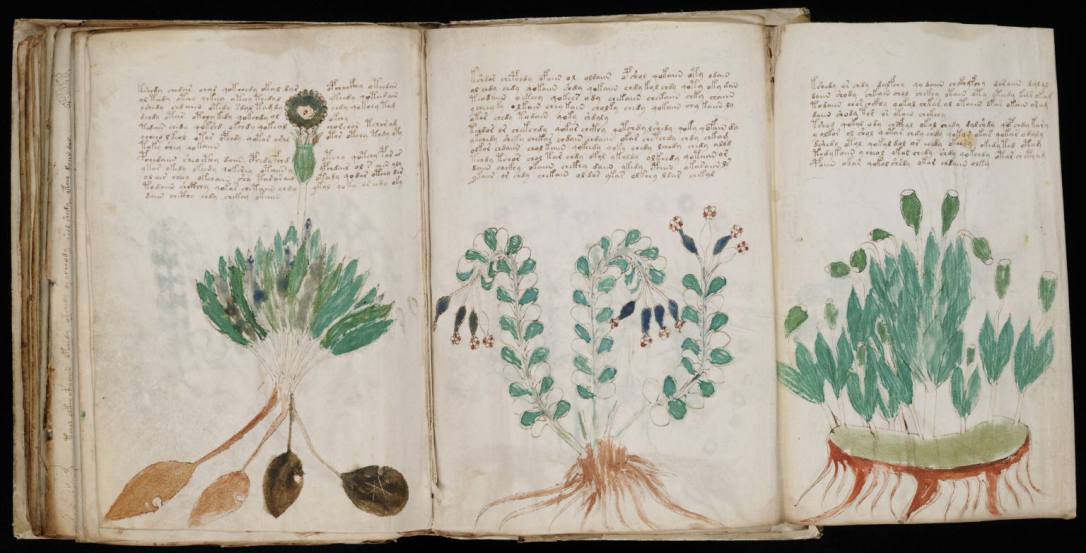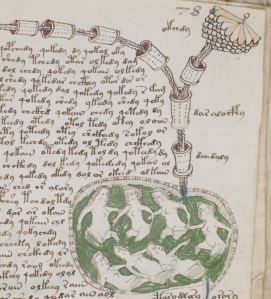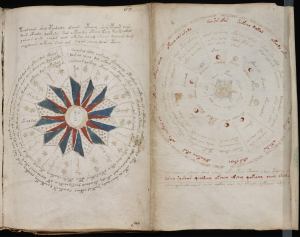
Where’s Robert Langdon when you need him? And what would the star of Dan Brown’s The Da Vinci Code make of the Voynich manuscript, the world’s most mysterious book?
The Voynich manuscript is well known today as the book that no one can read, and the code that no one can crack. The manuscript comprises writings and illustrations, but all the words are in an unknown language, and no one can decipher the meaning of the pictures either.
There are about 240 pages, with some missing, and the book has been carbon-dated to sometime between 1404 and 1438. Ever since its discovery in 1912, professional and amateur cryptographers – including British and American codebreakers from the First and Second World War – have worked tirelessly to decode it. But to this day, we are no closer to understanding the truth.
As with its contents, the creation and early history of the Voynich manuscript are shrouded in mystery. Georg Baresch, an alchemist from Prague, is the earliest confirmed owner in the early 1600s. Historical evidence confirms that he was trying to decipher the manuscript himself, but couldn’t. When Baresch died, the book passed to his friend, Johannes Marcus Marci, who eventually sent it to a scholar named Athanasius Kircher. A 1666 letter to Kircher, found inside the cover of the Voynich manuscript and written in Latin, confirms this.
This 1666 letter from Marci to Kircher also claimed that the book had once belonged to the Holy Roman Emperor Rudolf II in the late 1500s. But no earlier owners are known about, and any knowledge of who created it has been lost to time (or deliberately covered up).
After the book supposedly passed to Kircher, it disappeared from public record for 200 years. Then in 1912, a Polish book dealer named Wilfrid Voynich purchased 30 manuscripts from the Villa Mondragone in Italy. Among them was the mysterious manuscript that was henceforth named after him. Wilfrid Voynich spent the rest of his life investigating the origins of the book and trying to decipher its meaning – to no avail.
Unknown plants and naked women bathing
The 240 remaining pages of the Voynich manuscript are made from vellum or calf skin. It’s been determined that a quill pen, iron gall ink and coloured paint were used to create the text and drawings.
Interestingly, the text does appear to follow a pattern and a regular structure. The alphabet used is completely unknown, but there are spaces between letters to indicate words, there are certain letters that appear in every word, and there are some words that recur. Scattered throughout the unknown script are some Latin words, and it’s not known whether these were part of the original writings or added later.
There are some peculiarities though. Some letters appear only at the beginning, middle or end of a word. Some words appear up to three times in the same string of words. Words that differ by only one letter appear unusually frequently, and there is no punctuation.


Even more intriguing are the mysterious colour illustrations that accompany the text. There are circular diagrams with moons and stars and other astronomical symbols; drawings of naked women bathing together; objects resembling apothecary jars; and a whole range of plants that no one has been able to identify.
While nobody understands what any of this means, it’s generally believed that the manuscript is some kind of compendium and discussion of medieval herbal medicines.
But why can nobody identify the plants?
A hoax?
While lots of people believe that the Voynich manuscript is written in an unknown language, others are more sceptical of this possibility. British mathematician Gordon Rugg says:
“I don’t think there’s much chance that the Voynich manuscript is simply an unidentified language, because there are too many features in its text that are very different from anything found in any real language.”
And because even the world’s best codebreakers haven’t been able to crack it, many believe the Voynich manuscript to be a medieval hoax. In other words it’s all meaningless gibberish and was deliberately written as such.
However, the counter-argument is that the manuscript is perhaps too sophisticated to be a hoax. Some of its characteristics are so subtle that they only reveal themselves after careful analysis. Why on Earth would a hoaxer go to such elaborate lengths?
Aliens or time travellers
It’s no wonder that the mystery of the Voynich manuscript has inspired the popular imagination. Some think it’s the work of aliens. The reason we’re having so much trouble decoding it is because it’s written in an alien language, so of course it’s not going to have the same rules and patterns as human languages.
Okay, so there is something indisputably Earthly about the Voynich manuscript. It’s written on calf skin and features human females in hot tubs. But let’s think on this for a bit. What if the book is the result of an outside alien influence? What if a human wrote it while possessed by an alien? What if aliens lived among us in human form in the 16th century? (And what if they’re still here, laughing at us for still being completely in the dark?)
The unidentified plants could just be alien plants. Still, there is something quite Earthly about these as well. A couple of the plant drawings have been identified – with fairly reasonable certainty – as depicting wild pansies and maidenhair ferns. And botanist Hugh O’Neill believes that one illustration depicts a sunflower, though this is only speculative.
So what if these plants ARE from Earth? What if they’re from a future Earth, and therefore haven’t evolved yet? What if the author of the Voynich manuscript is a human from the distant future, who speaks and writes in a language that has changed beyond all recognition? And what if somehow the Voynich manuscript was transported back in time from this future Earth?
I think I’ve found the plot for my next Million Eyes short story 🙂
Next week: I think it’s about time I talked about Steven Avery…

To the question about the Voynich manuscript.
The text is written signs. Signs are used instead of letters of the alphabet one of the ancient languages. Moreover, in the text there are 2 levels of encryption. I found the key with which the first section I could read the following words: hemp, wearing hemp; food, food (sheet 20 at the numbering on the Internet); to clean (gut), knowledge, perhaps the desire, to drink, sweet beverage (nectar), maturation (maturity), to consider, to believe (sheet 107); to drink; six; flourishing; increasing; intense; peas; sweet drink, nectar, etc. Is just the short words, 2-3 sign. To translate words with more than 2-3 characters requires knowledge of this ancient language. The fact that some signs correspond to two letters. Thus, for example, a word consisting of three characters can fit up to six letters of which three. In the end, you need six characters to define the semantic word of three letters. Without knowledge of this language make it very difficult even with a dictionary.
If you are interested, I am ready to send more detailed information, including scans of pages showing the translated words.
Nicholas.
LikeLike
There is a key to cipher the Voynich manuscript.
The key to the cipher manuscript placed in the manuscript. It is placed throughout the text. Part of the key hints is placed on the sheet 14. With her help was able to translate a few dozen words that are completely relevant to the theme sections.
The Voynich manuscript is not written with letters. It is written in signs. Characters replace the letters of the alphabet one of the ancient language. Moreover, in the text there are 2 levels of encryption. I figured out the key by which the first section could read the following words: hemp, wearing hemp; food, food (sheet 20 at the numbering on the Internet); to clean (gut), knowledge, perhaps the desire, to drink, sweet beverage (nectar), maturation (maturity), to consider, to believe (sheet 107); to drink; six; flourishing; increasing; intense; peas; sweet drink, nectar, etc. Is just the short words, 2-3 sign. To translate words with more than 2-3 characters requires knowledge of this ancient language. The fact that some symbols represent two letters. In the end, the word consisting of three characters can fit up to six letters. Three letters are superfluous. In the end, you need six characters to define the semantic word of three letters. Of course, without knowledge of this language make it very difficult even with a We can say that the Voynich manuscript is an encyclopedia of knowledge that humanity needs today. I managed to partially solve the mystery of mount Kailas ( for example, its height is 6825 meters). The manuscript indicates the place where the Grail Is hidden, as well as the Font and Cradle of Jesus.
I am ready to share information.
With respect, Nikolai.
LikeLike
Cool, publish a paper on it.
LikeLike